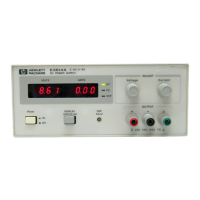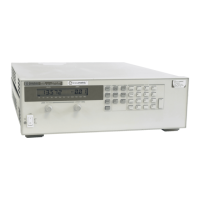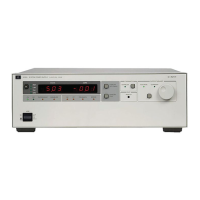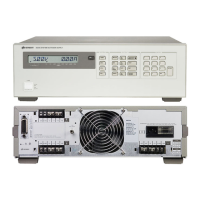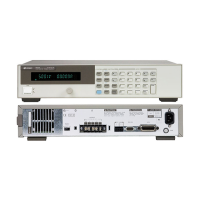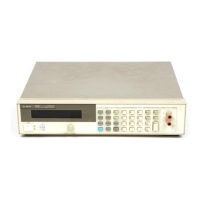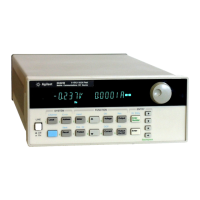Verification 17
b. Turn on the supply and program the current to the full scale current value and the output voltage to the maximum
programmable voltage value (see Table 2-3).
c. Adjust the load in the CV mode for full scale voltage as indicated on the front panel display. Check that the CC
annunciator is on. If it is not, adjust the load so that the output voltage drops slightly.
d. *Record the output current reading (DVM reading/current monitor resistance value in ohms).
e. *Short the load switch and record the output current reading.
The difference in the current readings in steps (d) and (e) is the load effect and should not exceed the limit specified in the
Performance Test Record Form for the appropriate model under CC LOAD EFFECT.
* You may want to use the average reading program described previously.
CC Source Effect
This test measures the change in output current that results when the AC line voltage changes from the minimum to the
maximum value within the specifications.
a. Turn off the supply and connect the AC power line through a variable voltage transformer.
b. Connect the output terminals as shown in Figure 2-1 with the DVM connected across the current monitoring resistor.
Set the transformer to the nominal line voltage.
c. Turn on the supply and program the current to the full scale value and the output voltage to the maximum
programmable value (see Table 2-3).
d. Adjust the load in the CV mode for full scale voltage as indicated on the front panel display. Check that the CC
annunciator is on. If it is not, adjust the load so that the output voltage drops slightly.
e. Adjust the transformer to 13% below the nominal line voltage.
f. *Record the output current reading (DVM reading/current monitoring resistor in ohms).
g. Adjust the transformer to 6% above the nominal line voltage.
h. *Record the output current reading again.
The difference in the current readings in steps (f) and (h) is the CC source effect and should not exceed the values listed in
the Performance Test Record Form for the appropriate model under CC SOURCE EFFECT.
*You may want to use the average reading program described previously.
CC Noise (PARD)
Periodic and random deviations (PARD) in the output (ripple and noise) combine to produce a residual AC current, as well,
as an AC voltage superimposed on the DC output. Constant current (CC) PARD is specified as the rms output current in a
frequency range 20 Hz to 20 MHz with the supply in CC operation.
a. Turn off the supply and connect the load resistor and rms voltmeter as shown in Figure 2-3. Leads should be as short as
possible to reduce noise pick-up. Use only a resistive load for this test.
b. Check the test setup for noise with the supply turned off. Other equipment (e.g. computer, DMM, etc.) may affect the
reading.
c. Turn on the supply and program the current to full scale and the output voltage to the maximum programmable value
(see Table 2-3).
d. The output current should be at the full scale rating with the CC annunciator on.
e. Divide the reading on the rms voltmeter by the load resistance to obtain rms current. It should not exceed the values
listed in the Performance Test Record Form for the appropriate model under CC NOISE (RMS).
